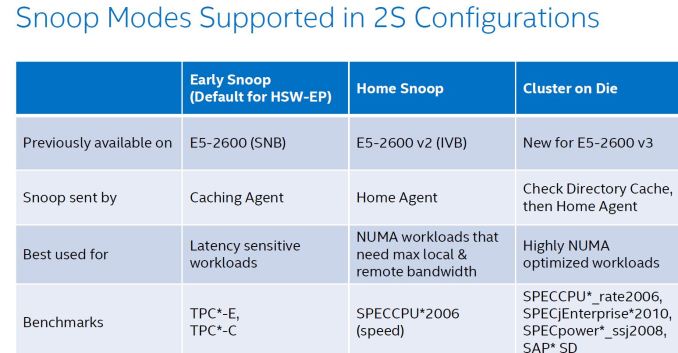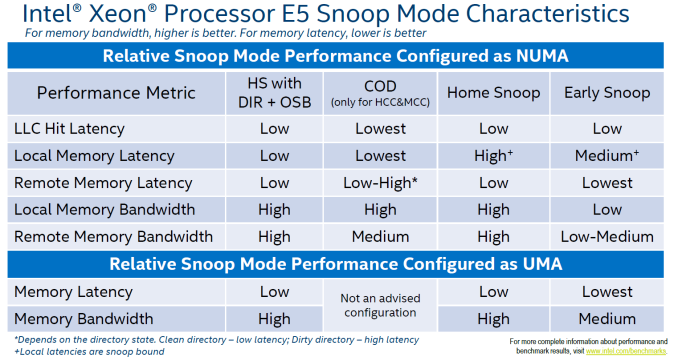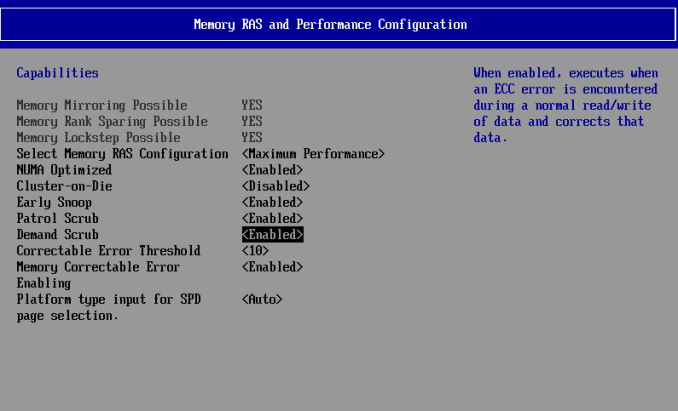The Intel Xeon E5 v4 Review: Testing Broadwell-EP With Demanding Server Workloads
by Johan De Gelas on March 31, 2016 12:30 PM EST- Posted in
- CPUs
- Intel
- Xeon
- Enterprise
- Enterprise CPUs
- Broadwell
Broadwell-EP: A 10,000 Foot View
What are the building blocks of a 22-core Xeon? The short answer: 24 cores, 2.5 MB L3-cache per core, 2 rings connected by 2 bridges (s-boxes) and several PCIe/QPI/home "agents".
The fact that only 22 of those 24 cores are activated in the top Xeon E5 SKU is purely a product differentiation decision. The 18 core Xeon E5 v3 used exactly the same die as the Xeon E7, and this has not changed in the new "Broadwell" generation.
The largest die (+/- 454 mm²), highest core (HCC) count SKUs still work with a two ring configuration connected by two bridges. The rings move data in opposite directions (clockwise/counter-clockwise) in order to reduce latency by allowing data to take the shortest path to the destination. The blue points indicate where data can jump onto the ring buses. Physical addresses are evenly distributed over the different cache slices (each 2.5 MB) to make sure that L3-cache accesses are also distributed, as a "hotspot" on one L3-cache slice would lower performance significantly. The L3-cache latency is rather variable: if the core is lucky enough to find the data in its own cache slice, only one extra cycle is needed (on top of the normal L1-L2-L3 latency). Getting a cacheline of another slice can cost up to 12 cycles, with an average cost of 6 cycles..
Meanwhile rings and other entities of the uncore work on a separate voltage plane and frequency. Power can be dynamically allocated to these entities, although the uncore parts are limited to 3 GHz.
Just like Haswell-EP, the Broadwell-EP Xeon E5 has three different die configurations. The second configuration supports 12 to 15 cores and is a smaller version (306mm²) of the third die configuration that we described above. These dies still have two memory controllers.
Otherwise the smallest 10 core die uses only one dual ring, two columns of cores, and only one memory controller. However, the memory controller drives 4 channels instead of 2, so there is a very small bandwidth penalty (5-10%) compared to the larger dies (HCC+MCC) with two memory controllers. The smaller die has a smaller L3-cache of course (25 MB max.). As the L3-cache gets smaller, latency is also a bit lower.
Cache Coherency
As the core count goes up, it gets increasingly complex to keep cache coherency. Intel uses the MESIF (Modified, Exclusive, shared, Invalid and Forward) protocol for cache coherency. The Home Agents inside the memory controller and the caching agents inside the L3-cache slice implement the cache coherency. To maintain consistency, a snoop mechanism is necessary. There are now no less than 4 different snoop methods.
The first, Early Snoop, was available starting with Sandy Bridge-EP models. With early snoop, caching agents broadcast snoop requests in the event of an L3-cache miss. Early snoop mode offers low latency, but it generates massive broadcasting traffic. As a result, it is not a good match for high core count dies running bandwidth intensive applications.
The second mode, Home Snoop, was introduced with Ivy Bridge. Cache line requests are no longer broadcasted but forwarded to the home agent in the home node. This adds a bit of latency, but significantly reduces the amount of cache coherency traffic.
Haswell-EP added a third mode, Cluster on Die (CoD). Each home agent has 14 KB directory cache. This directory cache keeps track of the contested cache lines to lower cache-to-cache transfer latencies. In the event of a request, it is checked first, and the directory cache returns a hit, snoops are only sent to indicated (by the directory cache) agents.
On Broadwell-EP, the dice are indeed split along the rings: all cores on one ring are one NUMA node, all other cores on the other ring make the second NUMA node. On Haswell-EP, the split was weirder, with one core of the second ring being a member of the first cluster. On top of that, CoD splits the processor in two NUMA nodes, more or less one node per ring.
The fourth mode, introduced with Broadwell EP, is the "home snoop" method, but improved with the use of the directory cache and yet another refinement called opportunistic snoop broadcast. This mode already starts snoops to the remote socket early and does the read of the memory directory in parallel instead of waiting for the latter to be done. This is the default snoop method on Broadwell EP.
This opportunistic snooping lowers the latency to remote memory.
These snoop modes can be set in the BIOS as you can see above.















112 Comments
View All Comments
jhh - Thursday, March 31, 2016 - link
The article says TSX-NI is supported on the E5, but if one looks at Intel ARK, it say it's not. Do the processors say they support TSX-NI? Or is this another one of the things which will be left for the E7?JohanAnandtech - Friday, April 1, 2016 - link
Intel's official slides say: "supports TSX". All SKUs, no exceptions.Oxford Guy - Thursday, March 31, 2016 - link
Bigger, badder, still obsolete cores.patrickjp93 - Friday, April 1, 2016 - link
Obsolete? Troll.Oxford Guy - Tuesday, April 5, 2016 - link
Unlike you, propagandist, I know what Skylake is.benzosaurus - Thursday, March 31, 2016 - link
"You can replace a dual Xeon 5680 with one Xeon E5-2699 v4 and almost double your performance while halving the CPU power consumption."I mean you can, but you can buy 4 X5680s for a quarter the price of a single E5-2699v4. It takes a lot of power savings to make that worthwhile. The pricing in the server market's always seemed weirdly non-linear to me.
warreo - Friday, April 1, 2016 - link
Presumably, it's not just about TCO. Space is at a premium in a datacenter, and so being able to fit more performance per sq ft also warrants a higher price, just like how notebook parts have historically been more expensive than their desktop equivalents.ShieTar - Friday, April 1, 2016 - link
But you don't get 4 1366-Systems for the price of one 2011-3 System. Depending on your Memory, Storage and Interconnect Needs, even two full Systems based on the Xeon 5680 may cost you more than one system based on the E5-2699 v4. One less Infiniband-Adapter can easily save you 500$ in Hardware.And you are not only halving the CPU power consumption, but also the power consumption of the rest of the system that you no longer use, so instead of 140W you are saving probably at least 200W per System, which can already add up to more than 1k$ in electricity and cooling bills for a 24/7 machine running for 3 years.
And last, but by no means least, less parts means less space, less chance for failure, less maintenance effort. If you happily waste a few hours here or there to maintain your own workstation, you don't do the math, but if you have to pay somebody to do it, salaries matter quickly. With an MTBF for an entire server rarely being much higher than 40.000, and recovery/repair easily taking you a person-day of work, each system generates about 1.7 hours of work per year. Cost of work (it's more than salaries, of course) probably comes up to 100$ for a skilled technical administrator, thus producing another 500$ over 3 years of added operational cost.
And of course, space matters as well. If your data center is filled, it can be more cost effective to replace the old CPUs with new expensive ones, rather than build a new facility to fill with more old Systems.
If you add it all up, I doubt you can get a System with an Xeon 5680 and operate it over 3 years for anything below 20.000$. So going from two 20.000$-Systems to a single 24.000$ Dollar System (because of an extra 4000$ for the big CPU) should save you a lot of money in the long run.
JohanAnandtech - Friday, April 1, 2016 - link
Where do you get your pricing info from? I can not imagine that server vendors still sell X5680s.extide - Friday, April 1, 2016 - link
Yeah, if you go used. No enterprise sysadmin worth his salt is ever going to put used gear that is not in warranty, and in support into production.